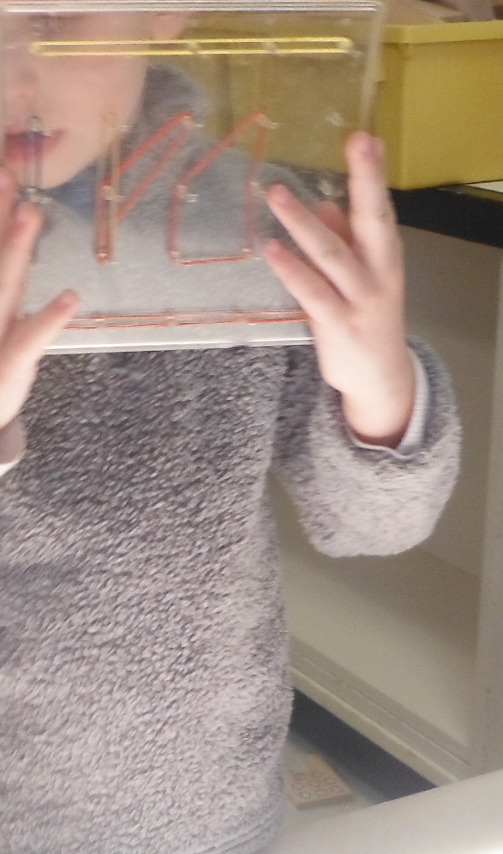Hello again!
Sorry to have been away for so long. Spring has actually arrived now and I’m less inclined to be inside typing after such a long winter of seclusion. We’ve had to be patient this year. Spring came reluctantly with many stuttering and faulty starts that bruised our fragile hearts. But come it did and it’s got me thinking a lot about patience as I’ve watched some of my students bloom beautifully over the past few weeks. Here’s the story of one of those blossomings.
At our morning meeting, I shared some photos of work that children had done with the geoboards and elastics on the light table.

I invited the children to explore shapes and lines at the light table. Two children, N & E, decided to work there during the first play block while several other children decided to work in the adjacent art studio. When I arrived to document their work, N had created this.

N: It’s a house.
Me: Tell me about the parts of your house
I’m pretty sure that N was just playing with the shapes and that he gave me what he thought was the ‘teacher-approved’ answer to my questioning presence. I was struggling to see how what he had made resembled a house.
N: It’s a strangler house.
Me: I don’t understand. What’s a strangler house?
At this point, O looked over from her place at the Art studio table and remarked on another geoboard that N had been working on.

O: That looks like train tracks.
N: Yeah, it’s train tracks.
Again, I’m not sure that N was actually making train tracks but O provided him with a bridge between what he had made and what it might represent.
Me: Oh, the train tracks, do you remember when we saw the train tracks on our walk?
N: Yeah!
At this point, I was called away to take pictures of another project. When I came back, N had created several more train track geo-boards. He had also taken some wooden blocks and was pretending that they were a train riding along the tracks. N usually plays in a very literal-minded way (a car is a car, an airplane is an airplane). This was the first time I had observed him using objects (the blocks and the geo-boards) to represent other objects (a train and the tracks).
Later in the week, we walked back towards the train tracks on our bi-weekly community walk. We had first sketched our observations six weeks earlier. This is what N drew the first time around.

“Train tracks” was all he had to say about his drawing at the time.
This is what he told me about the drawings he did on our second visit to the bridge. He was very engaged and didn’t want to leave.

Me: What can you tell me about your drawing?
N: Train tracks!
Me: What’s about these? (pointing to the lines)
N: Ch, ch, (drawing lines in the air) like a choo choo train!
Me: N, what are those called that you’re drawing in the air?
N: ….
Me: They’re lines, right?
N: lines!
While working on his sketch, N also had a very animated conversation with another child about his second and third drawings. N was trying to draw people in the windows of the building and the other child was telling him they didn’t look like people so N began adding eyes to their faces so that they resembled the other child’s drawings, exclaiming “this guy has one eye!”
N’s development over the course of this year can be viewed through the lens of psychologist Jerome Bruner’s Three Modes of Representation: Enactive (action-based), Iconic (image-based), and Symbolic (language-based).
Until very recently, N’s play has been mostly enactive. He likes to run, to make noises related to the toys he is using, and to engage in boisterous physical play. Any attempt to move him towards representing his interests in another way (drawing a pattern, writing his name) has been met with fierce opposition. N could teach the G-8 protestors a few things about resistance. His first attempt at drawing his bridge observations shows how un-iconic his thinking was. I think he drew what he did only because I insisted he had to draw something; he couldn’t just run around.
Both his play with the geo-boards and his second set of bridge drawings, show an amazing leap forward in his development. He is now happily using iconic forms of representation and he is accepting and using feedback from other students about his representations.
I think that N’s story speaks to the value of patience in children’s learning and development. There have been many times since September that I have felt frustrated by the pace of N’s development. I have been anxious about his future given his fierce resistance to anything resembling traditional academic skills. But, I have persisted in providing his with as rich an environment as possible, bringing him for walks, talking to him, and encouraging him to use all of the classroom materials. His recent breakthrough has confirmed my faith in the power of all of these things to empower children in their development of rich, deep thinking and representation. Instead of reducing N to a list to his deficits and focusing on the things he can’t yet do, I am energized by observing the amazing things he is learning to do every day!
